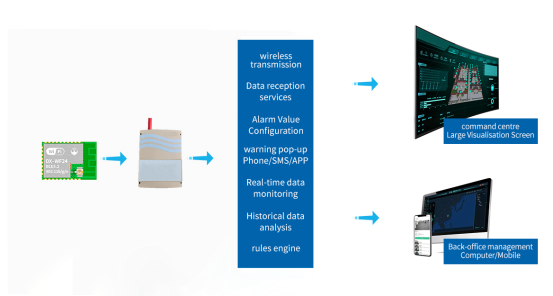






Release time:2024-03-07 Browsed0 order
In today's society, the rapid advancement of technology has brought tremendous changes to our lives, among which the application of Internet of Things technology is particularly remarkable. The Internet of Things connects any item to the network for information exchange and communication through various information sensing devices, such as radio frequency identification, infrared sensors, global positioning systems, etc., achieving intelligent identification, positioning, tracking, monitoring, and management. In recent years, the application of Internet of Things technology in the field of fire protection has increasingly demonstrated its powerful advantages
Smart firefighting typically utilizes wireless technology to improve the efficiency and effectiveness of firefighting work. Smart fire protection systems typically include intelligent fire alarm systems, video surveillance systems, remote monitoring and control systems for fire equipment, etc.

These systems can monitor fire risks in real time, provide warning information, automatically activate firefighting equipment, and remotely control and manage firefighting equipment. The intelligent fire protection system can also provide fire prediction and prevention suggestions through big data analysis and artificial intelligence technology, helping firefighters develop emergency plans and firefighting strategies more scientifically. Through intelligent firefighting systems, firefighting work can be more precise and efficient, greatly improving the ability to respond to and rescue fires.
Smart fire protection systems have many benefits, including:
1. Improving fire warning and monitoring capabilities: Smart firefighting can monitor fire risks in real time and provide timely warning information, which helps to detect fire hazards in advance and reduce the likelihood of fire occurrence.
2. Automated firefighting and emergency response: Smart firefighting can automatically activate firefighting equipment and quickly respond to fire incidents, reducing human intervention and improving firefighting efficiency.
3. Remote monitoring and management: Smart firefighting can remotely monitor and manage firefighting equipment, achieve remote control and fault diagnosis, and improve the reliability and maintenance efficiency of firefighting equipment.
4. Data analysis and predictive ability: Smart firefighting can provide firefighting prediction and prevention suggestions through big data analysis and artificial intelligence technology, helping firefighters develop emergency plans and firefighting strategies more scientifically.
5. Improving rescue efficiency: Smart firefighting can monitor the situation at the fire scene in real time and provide accurate information, which helps guide firefighters to carry out rescue operations more effectively, improving rescue efficiency and success rate.
Overall, smart fire protection systems can enhance the ability of fire prevention, monitoring, response, and rescue, ensuring the safety of people's lives and property.
